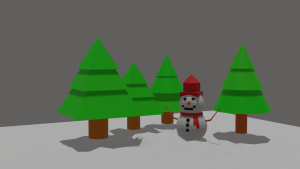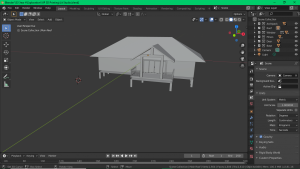VIP Center? It’s an acronym for Visitor Information Palace. Its name said it all. It’s a place where visitors can enlarge their understanding and knowledge about our school. VIP was first created/designed from a container more than 5 years ago. It got pretty old and some things were damaged, so why not have a VIP modification exploration. One of the seniors is helping to facilitate the exploration as well. For your information, a 3D printing of the school’s campus is included in the VIP. We spent the first few weeks just getting comfortable with “blender”; the software we are going to use to design our 3D models. In my opinion, it’s pretty hard, as I’m very new to this. However, I got more comfortable as we started to build our foundations and started designing easier models for practice like snowman. Overall I believe that this is a skill that is very helpful in future needs.
Designing Yearbook

Getting to be apart of creating the yearbook is something that I’m proud to be involved. This is the second yearbook that will be created by Liger students. The first yearbook was created four years ago by the first cohort. As a second cohort, we decided on creating another one that will be a combination of the two cohorts together. Basically a yearbook is a book that is usually packed with images and what we’ve done over the past few years. It’s similar to a look back or throwback or what’s being done. There might be field trips or events that are being featured. Aspects or perspectives of facilitators/staff could also be included. For this particular yearbook, there are more than 20 different sections. There are eight yearbook staff/students who are designing, as well as collecting contents for the book and I’m one of them. Each of us are responsible for three sections in the book. For instance, I’m responsible for collecting content and design the second cohort future predictions, the first cohort essentials and one of the biggest projects in Liger, Liger Marine Research Team (LMRT). It’s definitely a challenge for everyone to gather pictures from the past four years. Moreover, it’s even harder to design the layout for our separate sections, as we want our sections to be entertaining, informational and stylish at the same time. Certainly, we can’t finish the whole book in seven weeks, so we’ll be continuing this exploration later during the year. For this round, we’ve already decided on the color palettes, fonts and the theme, which is jOURney. I hope to continue this project in the near future.
Studying Mental Illness Through Literature Works

I really love the theme in this round’s literacy class. We’re learning about Mental illnesses through literary works. I was very surprised and sad to know that 60% of people with mental illness don’t seek out for help because they’re being stigmatized and classified as mentally ill. We read two older short, horrific and mysterious stories by a male famous American writer, Edgar Allan Poe. The first text was called The Tell Tale Heart, which is about a madman who doesn’t accept that he is insane. Because of a nice old man’s eye (it annoys him), the narrator killed the old man. Without any guilt at all he even hid the body under the floor and the police came to investigate and found nothing until the narrator eventually revealed the truth himself. The second story is called The Black Cat. The text is simpler and easier to understand than the first text. The Black Cat is a story that is quite similar to The Tell Tale Heart because the stories are told in the first person perspectives, who are the villains. The Black Cat is about a nice man (the narrator) who loved pets, especially cats and very graceful, until he started drinking alcohol. He started to change and become more aggressive, until one day he killed his own cat, while knowing that it didn’t do anything wrong. A few months later, he found another black cat to replace Pluto, the original cat. Not long after, he attempted to kill the cat, however his wife stopped him, so he killed his wife instead. Not very different from Poe’s The Tell Tale Heart story, the narrator hid the body within the house and kept chilled. I thought learning about the mental state through literature is very interesting and interacting simultaneously. I look forward to reading more creepy and fun texts.
One of the Best and Darkest Era
Cambodia, during the 1953-1970, also known as Sangkum Reas Niyum, was one of the most controversial periods in Cambodia’s history under the reign of King Norodom Sihanouk. The economy was at its peak, rising from all sectors such as; industry, agriculture, education, tourism, infrastructure, etc… We exported most products and imported very little goods. Unlike now, students back then, started working in workshops since elementary schools and were dressed up in really nice uniforms. Women wore Khmer traditional clothes as daily clothing. The financial in the family were really high as well. Unfortunately, Cambodia came to its end in its economy growth because of wars. Buildings were destroyed, educated people were eliminated, the lives of millions were lost, culture and traditions were stolen and the period was one of the darkest one yet. In groups of 4, we decided to choose one of the sectors and think of possible solutions to improve the sector, so it could grow as much as the Sangkum Reas Niyum era. Many sectors were discussed in class such as; education, infrastructure, health, fishery, etc… We hope to implement the solutions into actions one day in order to improve Cambodia’s economy in the upcoming years.
Household Garden
On the 12th of September, we went on a field trip to interview the farmers at Saang district in Kandal province. It’s a village that is the main transport of vegetables to the capital city, Phnom Penh. Although it’s the main vegetable transporter, they grow the vegetables chemically. The goals of the trip were to learn the reasons behind why they are growing the vegetables chemically and to really understand the process of growing using chemicals.
After interviewing about 25 farmers for the whole morning, we found out that there were several aspects behind the reasons of them growing chemical vegetables. The first factor that we identified was high market demands. Despite the fact that the whole village grow a variety of vegetables, the market demands were too high. The farmers mentioned that people love to buy fresh and healthy-looking vegetables, while organic vegetables don’t look fresh all the time and using chemicals could help the vegetables to grow faster and look fresh, which could satisfy the market’s demands on time.
The second reason we found was that the village doesn’t have enough resources to make organic materials needed to grow vegetables such as; cow dung, woody herbs, rice husks, burnt rice husks, different types of land, etc… They said that people used to own many cows, so it was easier to find cow dung, however as time passes, people are modernizing to adapt, evolve and keep up with the technological world. Farmers needed to buy cow dung from others, which costs a lot and it was hard to find the woody herbs in the village as well. Therefore, they have no other choice, but to choose chemical over organic.
The third and last cause is related to convenience and time to maintain the vegetables. To grow organic vegetables, the farmers needed to spend more effort and time on maintaining the vegetables, making sure that there are no bugs eating the vegetables, etc… On the other hand, if the farmers use chemical pesticides or other chemical materials, they put less effort, but the vegetables can still grow fast and ready to harvest on time to satisfy the needs of the markets. In addition, some of the farmers weren’t just only farmers, they also have other occupations to support their family, so they weren’t given enough time for taking care of the vegetables.
Some of my observations from the trip were that there were some farmers who have never tried growing organically, just because no one in the village grows organic vegetables. They don’t want to put the whole vegetable field at risk of not getting high quality vegetables on time. Furthermore, I’ve noticed that the farmers have a lot of experience growing vegetables, but they don’t have a lot of education about why are there more bugs as they use more chemicals. Some of them think that the soil was getting worse, not because of the chemicals, but because of the vegetables that are grown on the field. To maintain the soil, they use crop rotation method. In fact, crop rotation is a great way to maintain the nutrients in soil.
In conclusion, the trip was very successful, as we were able to meet our expectations and get a lot of incredible responses from the farmers, since they were very open. I learnt a lot about the way they use chemical and the changes of the vegetables that are sprayed by chemicals. I can now see a different perspective from the farmers that grow chemical vegetables. I believe that people need to be educated on the effects of chemicals, to stop using chemicals and start growing organic vegetables.



